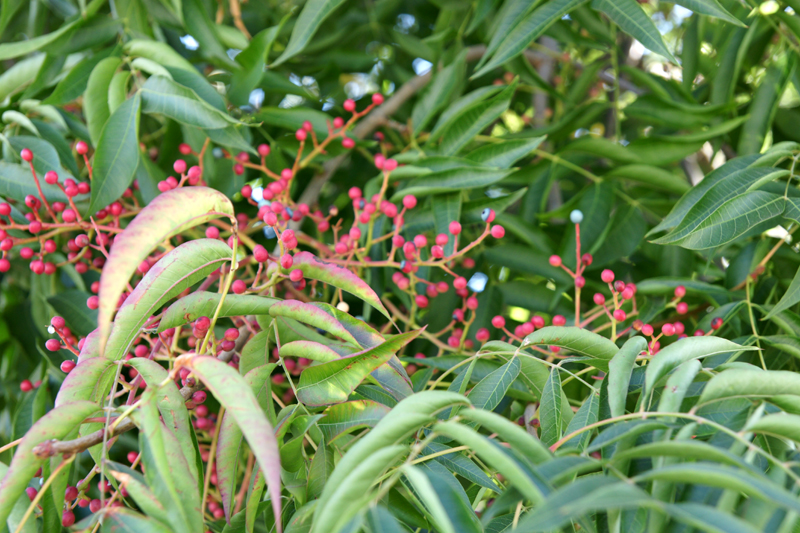|
Pistacia chinensis Bunge, Mém. Sav. Étr. Acad. St. Pétersbourg 2: 89 1835. (Syn: Pistacia formosana Matsum.; Pistacia philippinensis Merr. & Rolfe; Rhus argyi H. Lév.; Rhus gummifera H. Lév.);
Pistacia chinensis (English: Chinese pistache; Chinese: 黄连木; pinyin: huángliánmù) is a small to medium-sized tree in the genus Pistacia in the cashew family, Anacardiaceae, native to central and western China. It is hardy, can withstand harsh conditions and poor quality soils, and grows up to 20 m.[1] The leaves are deciduous, alternate, pinnate, 20-25 cm long, with 10 or 12 leaflets, the terminal leaflet usually absent. The flowers are produced in panicles 15-20 cm long at the ends of the branches; it is dioecious, with separate male and female plants. The fruit is a small red drupe, turning blue when ripe, containing a single seed. This species is planted as a street tree in temperate areas worldwide due to its attractive fruit and autumn foliage.
Some botanists merge Pistacia integerrima into this species as the subspecies P. chinensis ssp. integerrima, with the plants considered here then becoming the subspecies P. chinensis ssp. chinensis.
Its native range is on hill and mountain forests on rocky soils at 100-3600 m above sea level. It is found in China (except in the north) and Taiwan.[1]
Chinese pistache grows best in full sun, being intolerant of shade; it is the most frost-tolerant species of Pistacia, tolerating temperatures down to about -25°C, yet it is most highly regarded in warm climates. It is planted for its impressive fall colors, which develop at least as far south as Orlando, Florida. In the low-elevation deserts of Arizona, it is the only tree whose leaves turn scarlet in fall.
Horticulturally, it is a popular choice for street trees in urban settings because it is very drought tolerant and can survive harsh environments. It is also used as an understock for Pistacia vera.[2] In China, the oil from the seeds is used for biodiesel production. The wood is used for production of furniture and yields a yellow dye.[1]
(From Wikipedia on 28.10.14)
Tree For ID : Pink Berries : California : 16OCT14 : AK-2 : 10 posts by 3 authors. Attachments (3).
Again in Fremont, a very common tree full of tiny Pink berries, turning black when ripe.
Pictures taken on 28th Sept,14.
Brazilian Pepper Tree Schinus terebinthifolius
only because the berries seem to be not in any real graceful bunches, seem helter skelter bunch… and leaves are wider than the other schinus with pink berries .. and cant be more specific as to the variety since we dont have leaf sizes etc … the other tree with pink berries is my personal favorite: Peruvian pepper Schinus molle has gracefully hanging leaves and even more graceful bunches of pink berries. ALSO…. In such cases whole tree and trunk, esp bark is very important. These trees in malls parking lots and gardens are your captive audience, cant move, giving you chance to photograph trunk, bark and overall tree canopy and graceful carriage. Believe me the graceful tree canopy pictures will give you a great deal of pleasure for years to come. (in addition to sharing them with us, 🙂 …)
Schinus bark is very interesting, once you see it, cant forget it. OF course the tree needs to be a bit older than most of newer towns street trees or newer landscaping plantings. Yes Schinus terebinthifolius, very common in California. The other species S. molle has drooping branches with very narrow leaflets.
Schinus terebinthifolius and Schinus molle, both were seen by me and identified. I will post them seperately.
This was something else. Leaves reminded me of Meliaceae.
Will add more pictures.
Thanks … for alert. Now I remember, it is Pistasia chinensis.
Yes, it does match with images on searching. Adding more pictures, I believe it is the same one.
I have to be really sure, before I voice my views with great experts!!
Taken in Sacramento, on the 6th of Oct,14. Attachments (4).
Here are two for comparison. The leaves are distinctive. Attachments (2)
Thanks a lot. I am also posting my pictures.
could be but i need better pictures
such nice information should be sent in along with the query otherwise it leads to meandering alleys of knowledge as it did in this case… it would be nice and taken as goodwill among peers
|
Pistacia chinensis (USA- Cultivated)
Updated on December 24, 2024


